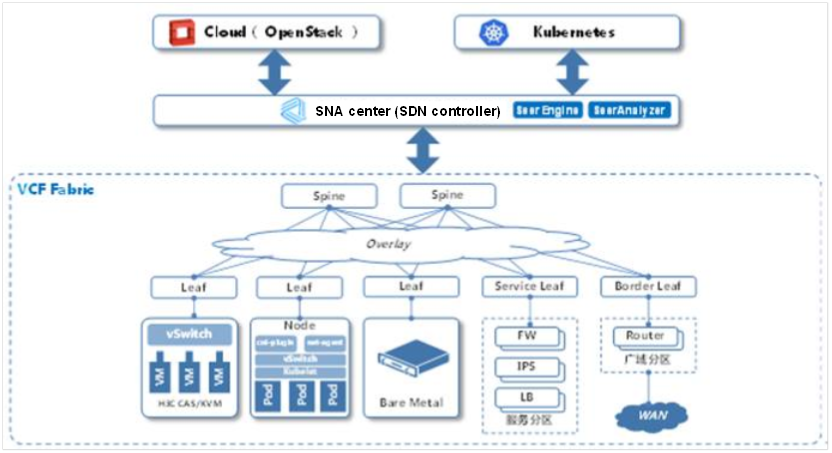Internet Data Center Network Solution
The growing scale of data centers increases networking complexity. The booming new infrastructure construction also triggers more demands for various types of digital infrastructure from companies and society. An efficient network that matches the scale of a data center is vital to keeping the data and services running smoothly in the data center. To build an efficient network, the first step is to choose a right network architecture.
Three data center scenarios and three networking models
With the deepening of digital transformation, "scenario-based" has become quite the buzzword for the past two years. While computing and storage devices are struggling to meet needs of different scenarios, scenario-based networks have taken firm root in the industry.
Engineers need to customize network solutions depending on the scale and application of data centers, just as people build different types of roads to deal with varying traffic needs.
Scenario 1: small- and medium-sized data center
The two-tier Clos architecture has been around for many years and it is now still the first choice for many industry customers. For small- and medium-sized data centers, we can still resort to this simple architecture and build a reliable network by using switches with continuously improved specifications. That's why the two-tier Clos architecture is so widely applied in small- and medium-sized data centers.
Typical two-tier Clos architecture: H3C AD-DC application-driven data center solution
In the two-tier Clos architecture, there are only two roles for devices on the network. The data forwarding path is short, as each Leaf switch is placed just one hop away from another. Therefore, the shorter the distance, the lower the latency. The unified access mode also brings great convenience for deployment and horizontal expansion, such as BGP deployment, policy control, routine maintenance, and troubleshooting.
The two-tier Clos architecture poses high requirements for Spine switches in terms of their performance and reliability. In most cases, modular core switches for data centers are used. A modular core switch has an independent control plane, forwarding plane, and support system, and features a redundancy design, which make the whole system more reliable than a fixed configuration switch.
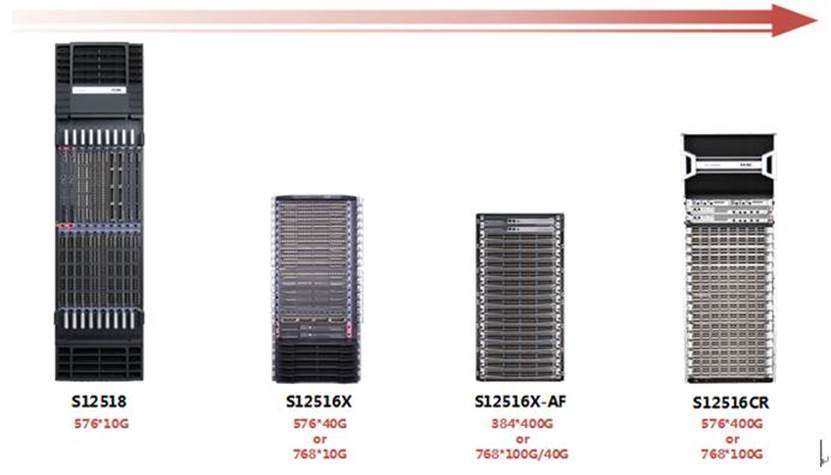
Performance evolution from 576*10G to 576*400G for H3C's modular core switches in data centers
The two-tier Clos architecture is more mature in adapting to the commercial SDN controllers. With SDN controllers, the EVPN-based network overlay solution can be quickly built, which reduces the complexity in deployment of east-west and south-north service chains, and meets the requirements of a network for associating all forms of computing resources, such as VMs, bare metal, and containers in cloud scenarios.
In addition, this architecture is also suitable for large companies' aggregation equipment rooms and edge equipment rooms that are deployed in different locations, to build edge computing networks, relieve backbone network pressure, and reduce access latency.
Scenario 2: medium- and large-sized data center
The two-tier Clos architecture is typically supposed to support less than 20,000 servers. While, the three-tier Clos architecture overcomes this bottleneck in network scale. The three-tier Clos architecture adds a layer of aggregation switches (Pod Spine) in the middle of the two-tier Clos architecture, so that a group of Pod Spine switches and all connected Leaf switches form a single pod, and multiple pods are then connected to form the entire network through Spine switches. The network can be horizontally expanded with added pods, which greatly improves the network scalability. With pod as the fundamental unit for deployment, the three-tier Clos architecture is more flexible in meeting diversified service requirements and providing differentiated services.
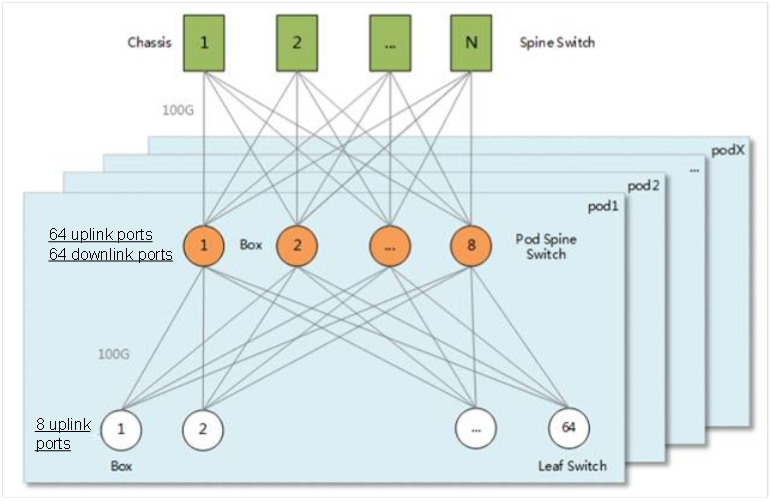
Example of the three-tier Clos architecture
After the layer of high-density aggregation switches (Pod Spine) is added, dozens of modular core switches can be deployed at the Spine layer and provide ports to connect dozens of pods. The whole network can support more than 100,000 servers.
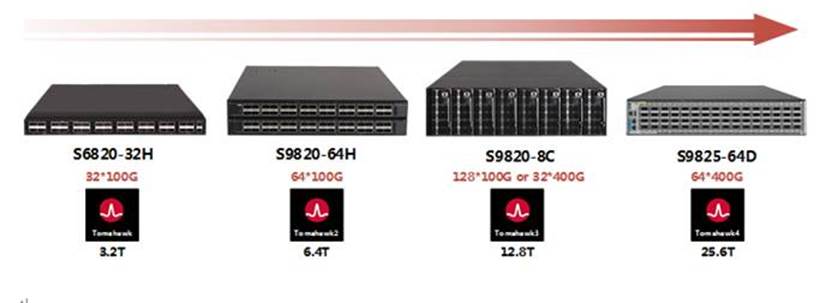
Performance evolution from 32*100G to 64*400G for H3C's high-density aggregation switches
In addition, the ratio of uplink and downlink ports of the Pod Spine switches in a pod can be adjusted to flexibly define the convergence ratio of the pod. This helps meet different service requirements while reducing costs and avoiding unnecessary waste.
Scenario 3: large- and super-large-sized data center
Internet enterprises can always refresh people's perception towards the word "massive", both at the business model level and at the infrastructure level. Business of hundreds of millions yuan or even billion yuan per minute poses higher requirements for the scale of data centers, which further drives the evolution of the network architecture. The multi-plane network architecture based on fixed-port devices is a new architecture for leading Internet companies to build networks for large- and super-large-sized data centers.
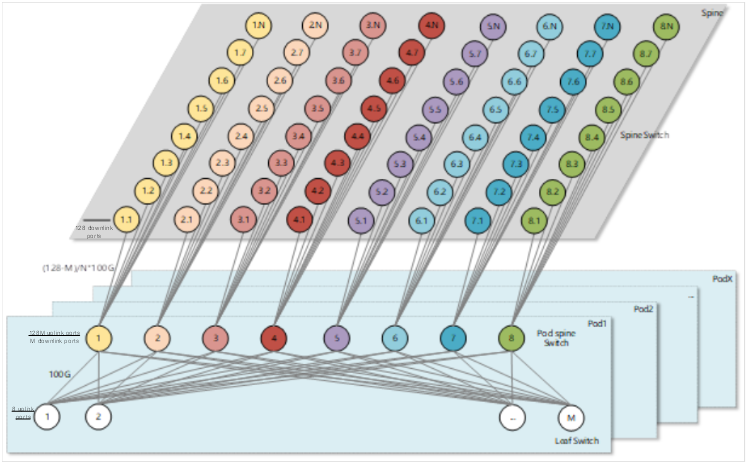
Example of multi-plane networking based on fixed-port devices
Unlike the three-tier Clos architecture where each Pod Spine switch needs to be connected to all switches at the Spine layer, the switches at the Spine layer in the new architecture are classified into groups (the number of groups is the same as the number of Pod Spine switches in each pod). In this way, the Spine switches in each group form a separate plane, and the Pod Spine switches in each pod only need to be connected to the Spine switches of the corresponding plane.
This allows the entire Spine layer to connect more pods and build a super-large-sized network with hundreds of thousands of servers. As performance of fixed configuration switches increases, this architecture can also allow for more capacity.
Moreover, Spine and Pod Spine switches use the same devices, delivering high consistency for the entire network in aspects such as functionality and forwarding delay. This brings a lot of advantages to service deployment and network tuning. In addition, the entire network is able to stay up to date as it can evolve from 100 G to 200 G, 400 G or even higher in the future.
Future data center network
01. Visual network management
From the above three different network solutions for data centers, we can find that no matter which architecture we select, management plays a vital role. Then the question arises as to how we implement more efficient network management at a lower cost.
Only if we have grasped the situation of traffic can we make traffic management more effective. Similarly, the efficient management of networks is only possible if they are visible.
In actual application scenarios, the network visualization technology is not only used for end-to-end traffic monitoring, early warning, and troubleshooting, but also helps to optimize the designing of the network architectures for data centers.
02. SmartNIC becomes a new terminal for networks

H3C switch +SmartNIC+UniServer end-to-end solution
In the future, SmartNICs will play a vital role in DCN. A SmartNIC with the programmable capability can release CPU resources and implement high-performance forwarding, and also provide functions such as tunnel encapsulation/decapsulation, virtual switching, encryption and decryption, and RDMA. As service scenarios and needs are becoming more diversified, a growing number of data-plane functions will be performed by SmartNICs. This can break the limitations of server-based or switch-based implementation, and hopefully achieve a perfect balance among performance, functionality, and flexibility.
Network progress never stops in the digital era
China has built nearly 5 million kilometers of roads in 70 years, which has directly contributed to the economic growth of the society. Similarly, companies will continuously dedicate their efforts to ensure efficient networks for their data centers. As a leading provider of digital solutions, H3C Group, a subsidiary of Unigroup, has taken root in the network field and has gained deep insight into the relationships among business values, data centers, and networks. In the digital era, an efficient data center network links up data, business, and value throughout the entire chain.
H3C Group will explore the new frontier of network technologies together with other vendors across industries and pave the way with data and value for the booming new infrastructure construction and the digital era.

